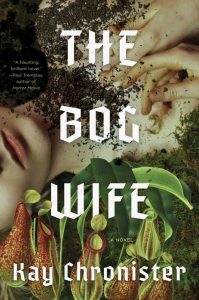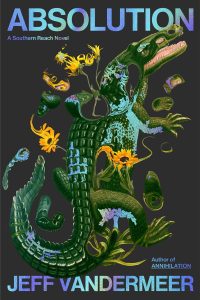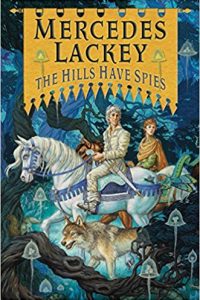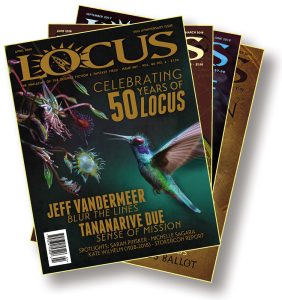The Bog Wife by Kay Chronister: Review by Ian Mond
 The Bog Wife, Kay Chronister (Counterpoint 978-1-64009-662-2, $28.00, 336pp, hc) October 2024. Cover by Nicole Caputo.
The Bog Wife, Kay Chronister (Counterpoint 978-1-64009-662-2, $28.00, 336pp, hc) October 2024. Cover by Nicole Caputo.
Like all conscientious and well-meaning readers, I strive to bring an open mind unsullied by prejudice and bias to any fiction work. However, based solely on the title and cover of Kay Chronister’s new novel, The Bog Wife, I assumed it was a revisionist fairytale based on Celtic mythology that takes place in provincial England. (It’s worth noting here that I never read the back cover copy). I was wrong on several counts. The Bog Wife is set in America – the mountains of West Virginia to be exact – during the present day, and while there’s a hint of the Celtic, the novel is less Wicker Man and more Appalachian Gothic. But even calling The Bog Wife gothic doesn’t feel entirely accurate. Yes, it has the trappings – a large, brooding house, ancient rituals, family secrets – but it also has a compassion for its characters that belies, even subverts, the conventional gothic tropes.
For centuries, the Haddesley family have lived and died in a ramshackle, multistorey house perched on top of the cranberry bogs in West Virginia. There, they have observed ancient traditions, guided by the seasons and the Borradh, the fragile holy book ‘‘with its violent and badly drawn pictures of people enacting the same rites that the [family] enacted still.’’ The most important of these rituals – the one that seals the compact between the Haddesleys and the bog – is the creation of the bog-wife, a woman formed from the peat who ‘‘marries’’ the male head of the family (always named Charles) and bears him children. When Wenna is 17, her mother vanishes. Wenna suspects her father of murder. Angry and disgusted, she breaks with centuries of tradition and leaves – not just the home but West Virginia. More than a decade later, Wenna is summoned back by her siblings, Charlie, Eda, Percy, and Nora, with news that her father is close to death. Despite significant reservations, she returns to West Virginia with a promise to leave after the ritual: her father’s sacrifice to the bog and, in turn, the birth of a new bog-wife. But when the bog doesn’t keep its part of the compact – no wife – the family, built, like the Haddesley house, on rotting foundations, begins to splinter apart.
The subversion of a well-established sub-genre does not require radical change. As Chronister proves, all it takes is a few subtle but clever tweaks. In The Bog Wife, the classic Gothic house, all brooding and mysterious, is a neglected monstrosity on the verge of collapse, while the tyrannical Gothic villain is dead and buried not even a quarter into the novel. Wenna is a damsel in distress – another feature of Gothic fiction – but not in the traditional sense: if Wenna is vulnerable, it’s because her marriage is over, and she hasn’t fully processed the trauma of her life as a Haddesley. But rather than be a victim of forces outside her control, Wenna is the one who brings change. She empowers her siblings – in ways she never intended – to reflect on and question their submerged identities. Charlie, the eldest brother, horrifically neutered by a hemlock tree crashing through his bedroom (and thus no longer capable of consummating his marriage with the bog-wife), is the first to act, to investigate the true history of the Haddesley family. On the other hand, Eda, who always acted in service of others – a role that became more pronounced when her sister left more than a decade ago – is willing to forgo her family’s strict values in the hope of binding them together.
It’s regarding the siblings where Chronister is at her most provocative. Gothic literature is well known for its exaggerated, grotesque characters (Silvia Moreno-Garcia’s Mexican Gothic is a terrific recent example of this). Given the novel’s conceit, heavily implying centuries of inbreeding, Chronister could easily have taken this path. You can imagine an alternate novel where Wenna’s ex-husband, desperate to have his wife back, arrives unannounced at the Haddesley house, only to be dealt with by the siblings. But Chronister treats her characters with tenderness. This doesn’t make the novel any less disquieting. Awareness that your life was based on a lie, that you’ve suppressed decades of trauma, that you never needed to feel this lonely, this afraid, this unloved, is still upsetting. But rather than view the siblings, including Wenna, as just victims, we view them as individuals, each, in their unique way, striving to make sense of what’s become of their lives. And Chronister does all this with prose that’s not flashy or reflexive but measured and unadorned, beautiful in its simplicity. The Bog Wife does more than subvert the Gothic tradition; it makes us care for its characters and the future that awaits them.
Interested in this title? Your purchase through the links below brings us a small amount of affiliate income and helps us keep doing all the reviews you love to read!
Ian Mond loves to talk about books. For eight years he co-hosted a book podcast, The Writer and the Critic, with Kirstyn McDermott. Recently he has revived his blog, The Hysterical Hamster, and is again posting mostly vulgar reviews on an eclectic range of literary and genre novels. You can also follow Ian on Twitter (@Mondyboy) or contact him at mondyboy74@gmail.com.
This review and more like it in the November 2024 issue of Locus.
 While you are here, please take a moment to support Locus with a one-time or recurring donation. We rely on reader donations to keep the magazine and site going, and would like to keep the site paywall free, but WE NEED YOUR FINANCIAL SUPPORT to continue quality coverage of the science fiction and fantasy field.
While you are here, please take a moment to support Locus with a one-time or recurring donation. We rely on reader donations to keep the magazine and site going, and would like to keep the site paywall free, but WE NEED YOUR FINANCIAL SUPPORT to continue quality coverage of the science fiction and fantasy field.
©Locus Magazine. Copyrighted material may not be republished without permission of LSFF.









